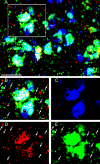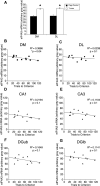Expression of the core exon-junction complex factor eukaryotic initiation factor 4A3 is increased during spatial exploration and striatally-mediated learning
- PMID: 22982623
- PMCID: PMC3490057
- DOI: 10.1016/j.neuroscience.2012.09.003
Expression of the core exon-junction complex factor eukaryotic initiation factor 4A3 is increased during spatial exploration and striatally-mediated learning
Abstract
Regulation of dendritically localized mRNAs offers an important means by which neurons can sculpt precise signals at synapses. Arc is one such dendritically localized mRNA, and it has been shown to contain two exon-junction complexes (EJCs) within its 3'UTR. The EJC has been postulated to regulate cytoplasmic Arc mRNA availability through translation-dependent decay and thus contribute to synaptic plasticity. Core proteins of the EJC include eIF4A3, an RNA helicase, and Magoh, which stabilizes the interaction of eIF4A3 with target mRNAs. Arc mRNA expression is activity-regulated in numerous brain regions, including the dorsal striatum and hippocampus. Therefore in this study, the in vivo expression of these core EJC components was investigated in adult Sprague-Dawley rats to determine whether there are also behaviorally regulated changes in their expression. In the present work, there was no change in the expression of Magoh mRNA following spatial exploration, a paradigm previously reported to robustly and reliably upregulate Arc mRNA expression. Interestingly, however, there were increases in eIF4A3 mRNA levels in the dorsal striatum and hippocampus following spatial exploration, similar to previous reports for Arc mRNA. Furthermore, there were activity-dependent changes in eIF4A3 protein distribution and expression within the striatum following spatial exploration. Importantly, eIF4A3 protein colocalized with Arc mRNA in vivo. Like Arc mRNA expression, eIF4A3 mRNA expression in the dorsomedial striatum, but not dorsolateral striatum or hippocampus, significantly correlated with behavioral performance on a striatally-mediated, response-reversal learning task. This study provides direct evidence that a core EJC component, eIF4A3, shows activity-dependent changes in both mRNA and protein expression in the adult mammalian brain. These findings thus further implicate eIF4A3 as a key mediator of Arc mRNA availability underlying learning and memory processes in vivo.
Copyright © 2012 IBRO. Published by Elsevier Ltd. All rights reserved.
Figures





Similar articles
-
Arc mRNA induction in striatal efferent neurons associated with response learning.Eur J Neurosci. 2007 Jul;26(1):228-41. doi: 10.1111/j.1460-9568.2007.05630.x. Eur J Neurosci. 2007. PMID: 17614950
-
Splicing remodels messenger ribonucleoprotein architecture via eIF4A3-dependent and -independent recruitment of exon junction complex components.Proc Natl Acad Sci U S A. 2007 Jul 10;104(28):11574-9. doi: 10.1073/pnas.0704946104. Epub 2007 Jul 2. Proc Natl Acad Sci U S A. 2007. PMID: 17606899 Free PMC article.
-
Spatial exploration induces ARC, a plasticity-related immediate-early gene, only in calcium/calmodulin-dependent protein kinase II-positive principal excitatory and inhibitory neurons of the rat forebrain.J Comp Neurol. 2006 Sep 20;498(3):317-29. doi: 10.1002/cne.21003. J Comp Neurol. 2006. PMID: 16871537
-
Roles of the exon junction complex components in the central nervous system: a mini review.Rev Neurosci. 2018 Nov 27;29(8):817-824. doi: 10.1515/revneuro-2017-0113. Rev Neurosci. 2018. PMID: 29791316 Review.
-
The Physiological Roles of the Exon Junction Complex in Development and Diseases.Cells. 2022 Apr 1;11(7):1192. doi: 10.3390/cells11071192. Cells. 2022. PMID: 35406756 Free PMC article. Review.
Cited by
-
A fine balance: Regulation of hippocampal Arc/Arg3.1 transcription, translation and degradation in a rat model of normal cognitive aging.Neurobiol Learn Mem. 2014 Nov;115:58-67. doi: 10.1016/j.nlm.2014.08.007. Epub 2014 Aug 23. Neurobiol Learn Mem. 2014. PMID: 25151943 Free PMC article.
-
A noncoding expansion in EIF4A3 causes Richieri-Costa-Pereira syndrome, a craniofacial disorder associated with limb defects.Am J Hum Genet. 2014 Jan 2;94(1):120-8. doi: 10.1016/j.ajhg.2013.11.020. Epub 2013 Dec 19. Am J Hum Genet. 2014. PMID: 24360810 Free PMC article.
-
Evaluating an etiologically relevant platform for therapy development for temporal lobe epilepsy: effects of carbamazepine and valproic acid on acute seizures and chronic behavioral comorbidities in the Theiler's murine encephalomyelitis virus mouse model.J Pharmacol Exp Ther. 2015 May;353(2):318-29. doi: 10.1124/jpet.114.222513. Epub 2015 Mar 9. J Pharmacol Exp Ther. 2015. PMID: 25755209 Free PMC article.
-
Phasic-like stimulation of the medial forebrain bundle augments striatal gene expression despite methamphetamine-induced partial dopamine denervation.J Neurochem. 2013 May;125(4):555-65. doi: 10.1111/jnc.12234. Epub 2013 Apr 1. J Neurochem. 2013. PMID: 23480199 Free PMC article.
-
Dendritic protein synthesis in the normal and diseased brain.Neuroscience. 2013 Mar 1;232:106-27. doi: 10.1016/j.neuroscience.2012.12.003. Epub 2012 Dec 20. Neuroscience. 2013. PMID: 23262237 Free PMC article. Review.
References
-
- Ashton-Beaucage D, Udell CM, Lavoie H, Baril C, Lefrancois M, Chagnon P, Gendron P, Caron-Lizotte O, Bonneil E, Thibault P, Therrien M. The exon junction complex controls the splicing of MAPK and other long intron-containing transcripts in Drosophila. Cell. 2010;143:251–262. - PubMed
-
- Ballut L, Marchadier B, Baguet A, Tomasetto C, Seraphin B, Le Hir H. The exon junction core complex is locked onto RNA by inhibition of eIF4AIII ATPase activity. Nat Struct Mol Biol. 2005;12:861–869. - PubMed
-
- Bolognani F, Merhege MA, Twiss J, Perrone-Bizzozero NI. Dendritic localization of the RNA-binding protein HuD in hippocampal neurons: association with polysomes and upregulation during contextual learning. Neurosci Lett. 2004;371:152–157. - PubMed
Publication types
MeSH terms
Substances
Grants and funding
LinkOut - more resources
Full Text Sources
Molecular Biology Databases

